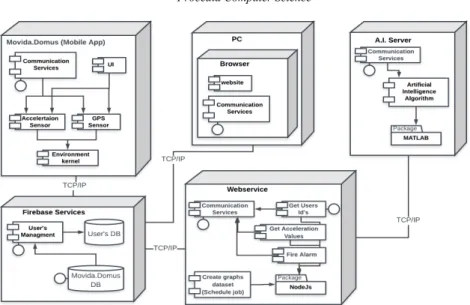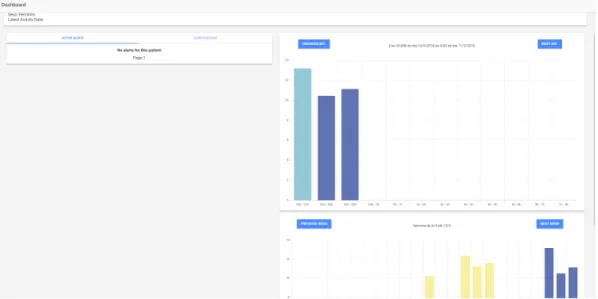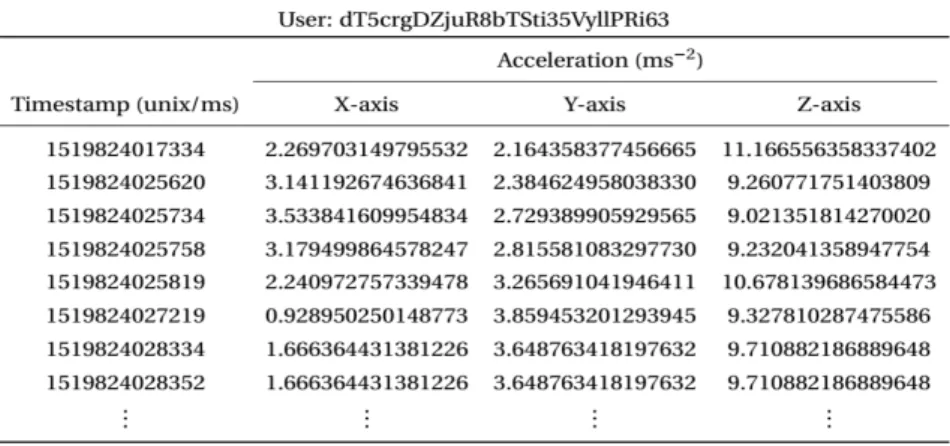ScienceDirect
Procedia Computer Science 00 (2018) 000–000
www.elsevier.com/locate/procedia
1877-0509 © 2018 The Authors. Published by Elsevier Ltd.
This is an open access article under the CC BY-NC-ND license (https://creativecommons.org/licenses/by-nc-nd/4.0/)
Selection and peer-review under responsibility of the scientific committee of the CENTERIS - International Conference on ENTERprise Information Systems / ProjMAN - International Conference on Project MANagement / HCist - International Conference on Health and Social Care Information Systems and Technologies.
CENTERIS - International Conference on ENTERprise Information Systems /
ProjMAN - International Conference on Project MANagement / HCist - International
Conference on Health and Social Care Information Systems and Technologies,
CENTERIS/ProjMAN/HCist 2018
Tracking human routines towards adaptive monitoring: the
MOVIDA.domus platform
Gonçalo Gordalina
a, João Figueiredo
b, Ricardo Martinho
a,d, Rui Rijo
a,c,d,e, Pedro Correia
b,
Pedro Assunção
a, Alexandra Seco
a, Gabriel Pires
b, Luís Oliveira
b, Rui Fonseca-Pinto
aaSchool of Technology and Management, Polytechnic Institute of Leiria, Leiria, Portugal bVITA Lab/Smart Cities Research Center(C2I2)/ Polytechnic Institute of Tomar, Tomar, Portugal
cInstitute for Systems Engineering and Computers at Coimbra (INESC Coimbra), University of Coimbra, Coimbra, Portugal dCentre for Research in Health Technologies and Information Systems (CINTESIS), University of Porto, Porto, PortugalHealth Intelligence
eLaboratory, Faculty of Medicine of the University of São Paulo, Ribeirão Preto/São Paulo, Brazil
Abstract
According to estimates by the World Health Organization, the average life expectancy will continue to rise. This indicator, being a measure of success in terms of healthcare, is not synonymous with quality of life and will increase healthcare costs.
Associated with this problem are also the changes in terms of the organization of society, which has not been able to solve these constraints of functional limitations, dementia, social isolation, and loneliness. This paper presents the concept of adaptive surveillance based on mobile technology and artificial intelligence, presented in the context of a global physical activity monitoring program (MOVIDA), in his domus dimension designed to the elderly people with some functional limitation or dementia. The proposed solution for an adaptive surveillance is thus to conduct direct supervision programs, to enroll persons who live alone or in nursing homes who need supervision without limiting their individual autonomy. The preliminary results show that it is possible to use the data obtained from a mobile smartphone to identify routines and use this information to identify daily patterns. Changes to these routine patterns can be used to generate alarms to caregivers.
© 2018 The Authors. Published by Elsevier Ltd.
This is an open access article under the CC BY-NC-ND license (https://creativecommons.org/licenses/by-nc-nd/4.0/) Selection and peer-review under responsibility of the scientific committee of the CENTERIS - International Conference on ENTERprise Information Systems / ProjMAN - International Conference on Project MANagement / HCist - International Conference on Health and Social Care Information Systems and Technologies.
2 Procedia Computer Science 1. Introduction
Aging is a natural physiological process for every person. According to World Health Organization (WHO), the number of people over 60 will double till 2050 [1]. With this increase in average life expectancy, the costs associated with the management of chronic and mental illnesses, but also related to the associated functional changes increases dramatically. Portugal is no exception regarding this phenomenon. In fact, the Official Statistics Office in Portugal (INE) released in 2015 a report on aging, pointing that for every 100 people under 64 years old, there are 141 people over the same age, making Portugal the fifth with the highest aging index in all European Union (EU)[2].
Moreover, the Portuguese elderly population suffers from some mental health diseases (i.e. Alzheimer Disease and other dementias). According to [3] the number of people over 84-year-old with dementia grew from around 40000, in 2003, to over 60000 in 2013, pointing to approximately 6% of the people over 60 having dementia.
There are other health issues, appearing in old age, that fall in the functional activity realm, as is the case of Rheumatoid arthritis. According to a health national inquiry, between 2005 and 2006, the percentage of people who have or had rheumatoid arthritis was 16.3%, presenting higher percentages for people over 85 years old [4].
Another factor associated not only with the number of years of life, but also to changes in society, is loneliness. According to Portugal census from 2011 [5 ], the number of people over 65 years old living alone grew 29% between 2001 and 2011.
The same source also states that the number of people over 65 years old living in a retirement home grew 28% within the same time frame.
The above-presented context of elderly people way of living, is characterized by functional physical and mental constraints, societal changes, and loneliness. All these issues converge in the need for constant surveillance by caregivers. However, this control must be linked with user autonomy. This strategy will conduct to a concept of adaptive surveillance based on the tracking of daily patterns of activity.
This paper presents one technical solution to implement an adaptive surveillance methodology, targeting elderly people or patients with mental health diseases. The solution is based on a platform and a mobile phone app to track and register a person’s activity and, by means of machine learning algorithms, identify changes to the daily routines, which will trigger an alarm.
The rest of this paper is organized as follows: in section 2 we present the developed solution architecture and its components Section 3 presents some preliminary results, and finally section 4 concludes the paper and presents future work.
2. MOVIDA.domus
The MOVIDA project is a community health program focused on monitoring and prescribing physical activity through the use of mobile technology. The MOVIDA.domus dimension focuses on the monitoring of activity patterns in order to detect daily routine changes.
The solution presented in the scope of this work is a preliminary version and was developed in partnership between the Polytechnic Institutes of Leiria (IPL) and Tomar (IPT). The IPL team developed the mobile application with the capabilities of tracking and register accelerometer and GPS data, the web platform to be used by caregivers, a webservice for communication purposes and Firebase [6] services configurations. The IPT team developed the Artificial Intelligence (A.I) algorithms to identify the activity patterns for each patient.
2.1 Architecture of the MOVIDA.domus platform
As presented in Figure 1 the architecture for the MOVIDA.domus project is comprised of 5 modules: mobile app; web Platform; firebase services; webservice; and A.I. server. And almost all of them are bridged with the Firebase services.
Firebase is a technology composed of many services, among others, users management service, a real-time No-SQL database, hosting, cloud functions, and cloud messaging. For the purpose of this project, the services used were: the real-time database to maintain all the data; the user’s management service to allow built-in authentication to the patients and caregivers, and the hosting service to host the web platform.
The mobile application and the web platform were built with Ionic [7] which is a cross-platform AngularJs and Typescript framework, enabling the possibility of having an Android and iOS app with just one source code; with Ionic is also possible to build a web architecture, which was used to the web platform. Both the mobile app and the web platform communicate with Firebase.
To fulfil the intent of this project with the Artificial Intelligence (AI) server, a webservice was developed to serve as a bridge between the data in Firebase and the respective A.I. server. This is a RESTful webservice using JSON as data structure and the technology used was NodeJs.
2.2 Mobile Application
As previously stated, the mobile application encapsulates the obtainment of the acceleration data and the geolocation provided by the GPS sensor. Figure 2 presents the simple user interface of this application; it shows the acceleration and the geolocation values to give the user some feedback.
Figure 1 - Movida.domus Architecture
4 Procedia Computer Science
The acquiring of the acceleration data is made by a cyclic method that fires with a frequency of 5Hz, corresponding to the x, y and z axis value of acceleration and the timestamp associated to that iteration. Data is then sent to the database. If the application is offline, the data is stored into the phone’s memory, like a buffer - with a limit of an hour of data - to be sent when the application comes online again.
The geolocation data is acquired differently as the correspondent method is always active and it only fires when the phone moves an acceptable distance (10 meters). The data returned by that method is the latitude, longitude and the timestamp associated. After that, this data is handled in the same way as the acceleration data.
2.3 Web Application
The web platform was developed with the purpose of being used by caregivers, enabling a quick insight of the patient’s states.
Figure 4 represents the detail of patient page where there’s a dashboard presenting basic personal information, a list of alerts sent to that specific patient and two graphs representing a hourly activity by that patient: a weekly chart and a chart corresponding to 8 hours of data.
2.4 webservice
As presented before, the purpose of this webservice is to link the acceleration data stored in the Firebase to the A.I. server module.
One of its endpoint is a GET request to obtain the patient's IDs. With one ID, the A.I. server can make another GET request to the endpoint of the acceleration data, passing by parameter the given ID. Id the A.I. server detects an anomaly, it can use the other endpoint of this webservice: a POST request to fire an alert and sending required data to structure the alert.
This webservice also has method that fires hourly, to transform the acceleration raw data into lighter, smaller, chunks to supply the graphs of the dashboard of a patient in the web platform.
2.5 Artificial Intelligence Server
The artificial intelligence server is responsible for getting the smartphone’s sensor data (such as acceleration values and GPS), process these data, and if applicable, send alarms according to the activity pattern and location of each user.
The main objectives are the classification of levels of physical activity and the recognition of activity patterns. Therefore, there are two tasks that require different approaches that can later be combined.
The accuracy of physical activity classification depends on various factors involving all levels of the process: the population studied and their environment, the number of sensors used, the window size of the data, the features used, etc. [8].
In this work, the sensing data are limited to those available in the smartphone. This has the advantage of not increasing the intrusiveness of the system in each end-user, but makes the application more challenging due to data scarcity and due to the lack of usability of the smartphone. Additionally, in order to increase energy savings and reduce the amount of data collected, the sampling frequency is relatively low. This can limit the classification accuracy for specific activity patterns, however the challenge of the solution is to find activity levels that could be used to infer that user are performing their usual activity.
Currently, data processing runs on a MATLAB server (the A.I. server). Using webservices, an automatic method was created to access the raw data (x, y, z-axis acceleration, GPS and timestamp). A timer object allows the execution of scripts at a given time interval, currently ten minutes. These scripts include the GET requests necessary to get the user ids and the related data, as exemplified in Fig. 4.
2.5.1 Data analysis
Figure 5 shows an example of the norm of the acceleration obtained during three days of activity of one user. The challenge is to find individual patterns of activity and find abnormal shifts of these patterns which should trigger alerts.
Figure 4 - User acceleration values
6 Procedia Computer Science
Taking the activity data of each user, several features were extracted and analysed to infer their discriminatory power. The initial approach was to fit a distribution to features extracted within specific hours during several days [9]. A probability density function (pdf) was taken for different features, namely mean, standard deviation, frequency information and others. For example, Figure 6 shows the pdf of a feature that represents the time difference between maximum and minimum.
This type of feature extraction is encouraging, as we could use the statistical information for activity level recognition and try to produce consistent and useful alert notification.
2.5.2 Alert notification
Presently, the system is able to send alerts when the end user has no activity reported during some time, based on the raw data and respective timestamp. Additionally, using GPS data, the system is able to find the most favourite place of the end user, sending an alert if her/his location is too far (100 meters) from that mentioned place.
3. Preliminary Results
Some preliminary tests were made with elements of the project team and some volunteers. It was possible for the A.I. server to define activity patterns and send alarms accordingly.
We are preparing tests with real users that precedes the scientific study of the impact of this platform.
4. Conclusion and Future Work
The societal changes and the increase in the average life expectancy entail costs for the health system but also to informal caregivers. The use of mobile technology associated with the capacity to process large amounts of data, and the use of this information to feed artificial intelligence algorithms has great potential in the monitoring of daily routines. In particular, this technology can play a central role in the development of adaptive surveillance solutions, as is the case of the I presented in this work.
The preliminary results presented here make it clear that it is possible, based on the technology that smartphones have, to develop monitoring strategies aided by artificial intelligence techniques.
For future work, is expected an optimization of the artificial intelligence algorithm. The webservice will suffer some optimization as well to make it simpler and faster with the requests. The geolocation system implemented in the mobile application will have some new features as well to help the artificial intelligence algorithm to reduce the false negatives and positives. Some of those features will be a way to create one or multiple locations to function as a center point to create a radius to enclosure the patient; and alert the caregivers if the patient is outside that area.
Acknowledgements
This work was supported by Fundação para a Ciência e Tecnologia FCT- Portugal, under the scope of MOVIDA project: 02/SAICT/2016 - 23878
References
[1] APP, “Associação Portuguesa de Psicogerontologia”, 06 Mar 2016. Available in: http://www.app.com.pt/relatorio-mundial-de envelhecimento-e-saude-da-organizacao-mundial-da-saude-oms-2015. [Accessed in 7 May 2018].
[2] I. N. Estatística (2015) “Envelhecimento da população residente em Portugal e na União Europeia” Destaque.
[3] Isabel Santana, Filipa Farinha, Sandra Freitas, Vitor Rodrigues, and Àlvaro Carvalho (2015) “Epidemiologia da Demência e da Doença de Alzheimer em Portugal: Estimativas da Prevalência e dos Encargos Financeiros. com a Medicação” Acta Med Port 28(2):182-188.
[4] Raquel Lucas, and Maria Teresa Monjardino (2010) “O estado da Reumatologia em Portugal” Observatório Nacional das Doenças Reumáticas Programa
[5] I. N. Estatística (2011) “Mais de um milhão e duzentos mil idosos vivem sós ou em companhia de outros idosos” Destaque. [6] Firebase. Available in: https://firebase.google.com/. [Accessed in 14 May 2018]
[7] Ionic Framework. Available in: https://ionicframework.com/. [Accessed in 14 May 2018]
[8] Awais M., Palmerini L., Bourke A. K., Ihlen E. A. F., Helbostad J. L., Chiari L., 2016, “Performance Evaluation of State of the Art Systems for Physical Activity Classification of Older Subjects Using Inertial Sensors in a Real Life Scenario: A Benchmark Study”, Sensors; Multidisciplinary Digital Publishing Institute, doi:10.3390/s16122105.



